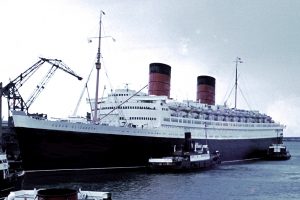seawise university
 On September 27, 1938, the largest passenger ship of its time, the Queen Elizabeth, named after the wife of King George VI was launched. The ship was the epitome of luxury. And those fortunate enough to sail on it were treated to every luxury imaginable, at least until World War II came about. When World War II began, the Queen Elizabeth was sent to New York to protect it from German bombs. It was docked next to the Normandie and the Queen Mary, the other two largest passenger ships of the time. As the war progressed, the Queen Elizabeth was called into service as a troop transport ship. It carried nearly 1 million soldiers before the war ended. After the war, the ship returned to commercial service and became one of the dominant transatlantic carriers, hauling thousands of people back and forth between England and the United States. It was once again doing the work it was designed for.
On September 27, 1938, the largest passenger ship of its time, the Queen Elizabeth, named after the wife of King George VI was launched. The ship was the epitome of luxury. And those fortunate enough to sail on it were treated to every luxury imaginable, at least until World War II came about. When World War II began, the Queen Elizabeth was sent to New York to protect it from German bombs. It was docked next to the Normandie and the Queen Mary, the other two largest passenger ships of the time. As the war progressed, the Queen Elizabeth was called into service as a troop transport ship. It carried nearly 1 million soldiers before the war ended. After the war, the ship returned to commercial service and became one of the dominant transatlantic carriers, hauling thousands of people back and forth between England and the United States. It was once again doing the work it was designed for.
In 1968, the ship’s owner, the Cunard Steamship Company, sold the Queen Elizabeth. The purchasing company planned to make it a tourist attraction and hotel in Philadelphia. The plans were scrapped when the aging ship was deemed a fire hazard. Two years later it was sold to Hong Kong businessman CY Tung, who wanted to use the ship as a floating college. Tung renamed the ship, Seawise University and sent it to Hong Kong Harbor for refitting. On January 9, 1972, as the ship neared the completion of the £5 million conversion, it caught fire. The fire was thought by some to have been arson, because several blazes broke out simultaneously throughout the ship. The fact that CY Tung had acquired the vessel for $3.5 million, and had insured it for $8 million, led some to speculate that the inferno was part of a fraud to collect on the insurance claim. Others speculated that the  fires were the result of a conflict between Tung, a Chinese Nationalist, and Communist-dominated ship construction unions. Virtually, the entire Hong Kong firefighting force turned out to try to save the ship, but despite their heroic efforts over two long days, the ship turned on its side and sank to the bottom of the harbor, which was apparently not very deep, because over half of the ship could be seen above the water until it was dismantled and sold for scrap between 1974 and 1975, because it had been deemed a shipping hazard. Fortunately, no one was killed in the fire. Shortly before it was scrapped, the wreck served as the backdrop for a key scene in The Man With the Golden Gun, a 1974 James Bond film starring Roger Moore.
fires were the result of a conflict between Tung, a Chinese Nationalist, and Communist-dominated ship construction unions. Virtually, the entire Hong Kong firefighting force turned out to try to save the ship, but despite their heroic efforts over two long days, the ship turned on its side and sank to the bottom of the harbor, which was apparently not very deep, because over half of the ship could be seen above the water until it was dismantled and sold for scrap between 1974 and 1975, because it had been deemed a shipping hazard. Fortunately, no one was killed in the fire. Shortly before it was scrapped, the wreck served as the backdrop for a key scene in The Man With the Golden Gun, a 1974 James Bond film starring Roger Moore.

